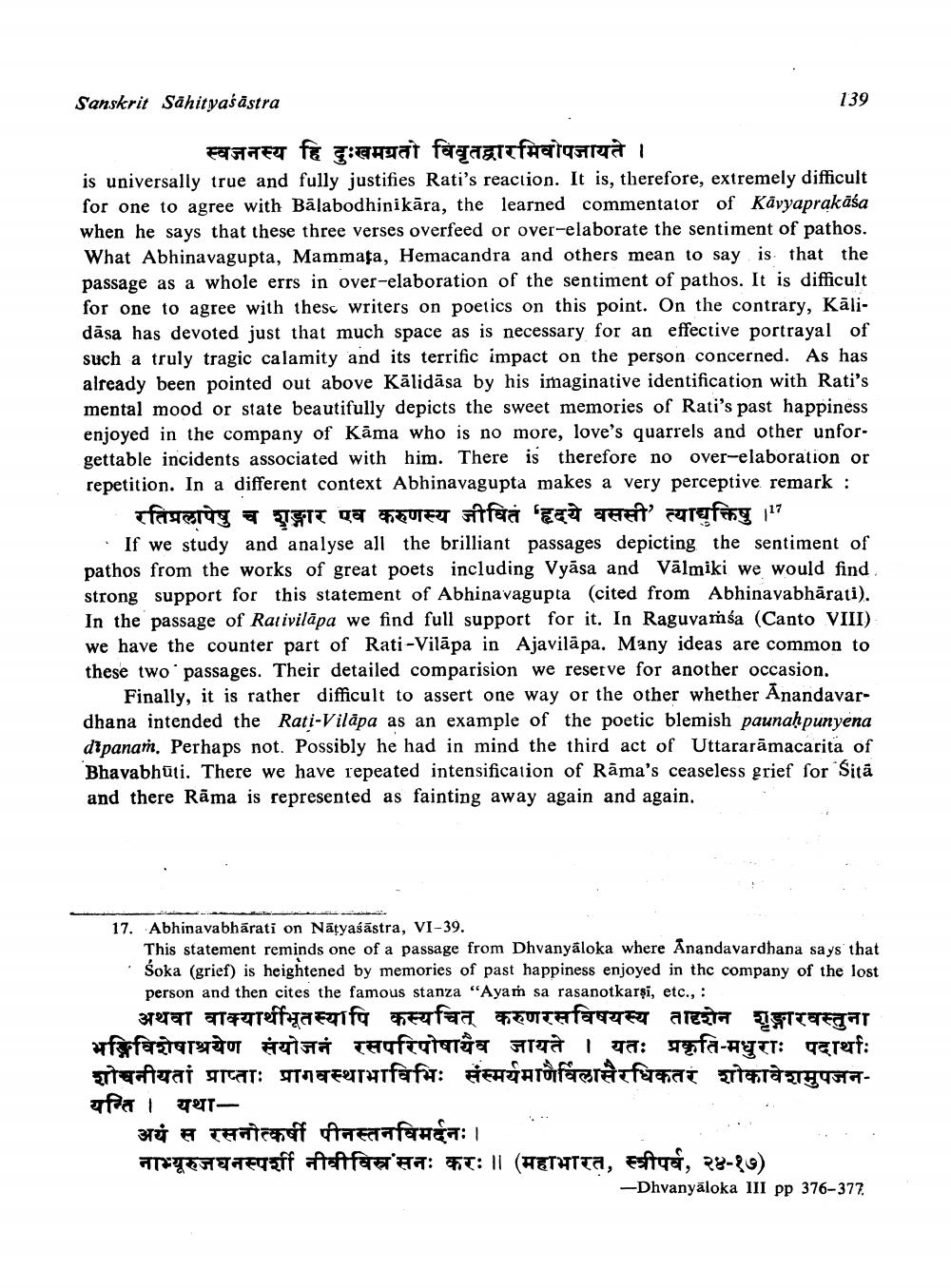________________
Sanskrit Sahityaśāstra
139
स्वजनस्य हि दुःखमग्रतो विवृतद्वारमिवोपजायते । is universally true and fully justifies Rati's reaction. It is, therefore, extremely difficult for one to agree with Bālabodhinikāra, the learned commentator of Kävyaprakāśa when he says that these three verses overfeed or over-elaborate the sentiment of pathos. What Abhinavagupta, Mammaţa, Hemacandra and others mean to say is that the passage as a whole errs in over-elaboration of the sentiment of pathos. It is difficult for one to agree with thesc writers on poetics on this point. On the contrary, Kālidāsa has devoted just that much space as is necessary for an effective portrayal of such a truly tragic calamity and its terrific impact on the person concerned. As has already been pointed out above Kālidāsa by his imaginative identification with Rati's mental mood or state beautifully depicts the sweet memories of Rati's past happiness enjoyed in the company of Kāma who is no more, love's quarrels and other unforgettable incidents associated with him. There is therefore no over-elaboration or repetition. In a different context Abhinavagupta makes a very perceptive remark :
- रतिप्रलापेषु च शृङ्गार एव करुणस्य जीवितं 'हृदये वससी' त्याधुक्तिषु ।"
• If we study and analyse all the brilliant passages depicting the sentiment of pathos from the works of great poets including Vyāsa and Vālmiki we would find strong support for this statement of Abhinavagupta (cited from Abhinavabhārati). In the passage of Rarivilāpa we find full support for it. In Raguvassa (Canto VIII) we have the counter part of Rati-Vilāpa in Ajaviläpa. Many ideas are common to these two passages. Their detailed comparision we reserve for another occasion.
Finally, it is rather difficult to assert one way or the other whether Anandavardhana intended the Rati-Vilāpa as an example of the poetic blemish paunaḥpunyena dipanan. Perhaps not. Possibly he had in mind the third act of Uttararāmacarita of Bhavabhūti. There we have repeated intensification of Rāma's ceaseless grief for Sitā and there Rāma is represented as fainting away again and again.
17. Abhinavabhārati on Nätyaśāstra, VI-39.
This statement reminds one of a passage from Dhvanyaloka where Anandavardhana says that Soka (grief) is heightened by memories of past happiness enjoyed in thc company of the lost person and then cites the famous stanza "Ayam sa rasanotkarşi, etc., :
अथवा वाक्यार्थीभूतस्यापि कस्यचित् करुणरसविषयस्य ताशेन शुङ्गारवस्तुना भङ्गिविशेषाश्रयेण संयोजनं रसपरिपोषायैव जायते । यतः प्रकृति-मधुराः पदार्थाः शोचनीयतां प्राप्ताः प्रागवस्थाभाविभिः संस्मर्यमाणैर्विलासैरधिकतर शोकावेशमुपजनofa l Te
अयं स रसनोत्कर्षी पीनस्तनविमर्दनः । ATT Freaegaff ofeffaa'wa: T: 11 (HETHTTa, situar, 28-80)
-Dhvanyāloka III pp 376-377.




